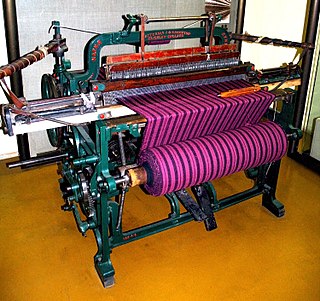
A loom is a device used to weave cloth and tapestry. The basic purpose of any loom is to hold the warp threads under tension to facilitate the interweaving of the weft threads. The precise shape of the loom and its mechanics may vary, but the basic function is the same.

Weaving is a method of textile production in which two distinct sets of yarns or threads are interlaced at right angles to form a fabric or cloth. Other methods are knitting, crocheting, felting, and braiding or plaiting. The longitudinal threads are called the warp and the lateral threads are the weft, woof, or filling. The method in which these threads are interwoven affects the characteristics of the cloth. Cloth is usually woven on a loom, a device that holds the warp threads in place while filling threads are woven through them. A fabric band that meets this definition of cloth can also be made using other methods, including tablet weaving, back strap loom, or other techniques that can be done without looms.

The malong is a traditional Filipino-Bangsamoro rectangular or tube-like wraparound skirt bearing a variety of geometric or okir designs. The malong is traditionally used as a garment by both men and women of the numerous ethnic groups in the mainland Mindanao and parts of the Sulu Archipelago. They are wrapped around at waist or chest-height and secured by tucked ends, with belts of braided material or other pieces of cloth, or are knotted over one shoulder. They were traditionally hand-woven, with the patterns usually distinctive to a particular ethnic group. However, modern malong are usually machine-made or even imported, with patterns that mimic the traditional local designs.
Syne Mitchell is an American novelist in the science fiction genre. She has a bachelor's degree in business administration and master's degree in physics. She lives in Seattle, Washington and is married to author Eric S. Nylund. Her first science fiction novel was Murphy’s Gambit which won the Compton Crook Award in 2001. Followed by science fiction novels Technogenesis in 2001, The Changeling Plague in 2003, End in Fire in 2005 and the first installment of the Deathless series, called The Last Mortal Man in 2006.
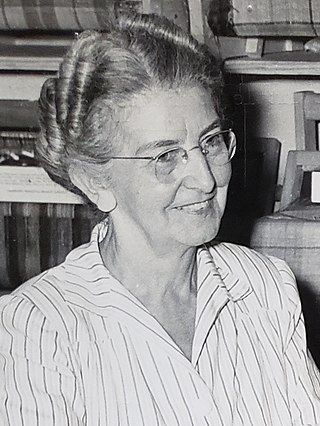
Ada K. Dietz was an American weaver best known for her 1949 monograph Algebraic Expressions in Handwoven Textiles, which defines a novel method for generating weaving patterns based on algebraic patterns. Her method employs the expansion of multivariate polynomials to devise a weaving scheme. Dietz' work is still well-regarded today, by both weavers and mathematicians. Along with the references listed below, Griswold (2001) cites several additional articles on her work.
Band weaving refers to the hand production of narrow woven fabric. This fabric may be called tape, band, inkle, strap, belt, back strap, trim, and more. It can be accomplished on a variety of types of looms, including inkle, band, tape, backstrap, and rigid heddle looms. Hole and slot heddles are also designed to weave bands. Depending on which loom is used, the material could be warp-faced or a balanced weave.

A heddle or heald is an integral part of a loom. Each thread in the warp passes through a heddle, which is used to separate the warp threads for the passage of the weft. The typical heddle is made of cord or wire and is suspended on a shaft of a loom. Each heddle has an eye in the center where the warp is threaded through. As there is one heddle for each thread of the warp, there can be near a thousand heddles used for fine or wide warps. A handwoven tea-towel will generally have between 300 and 400 warp threads and thus use that many heddles.

A weavers' cottage was a type of house used by weavers for cloth production in the putting-out system sometimes known as the domestic system.

A reed is part of a weaving loom, and resembles a comb or a frame with many vertical slits. It is used to separate and space the warp threads, to guide the shuttle's motion across the loom, and to push the weft threads into place. In most floor looms with, the reed is securely held by the beater. Floor looms and mechanized looms both use a beater with a reed, whereas Inkle weaving and tablet weaving do not use reeds.
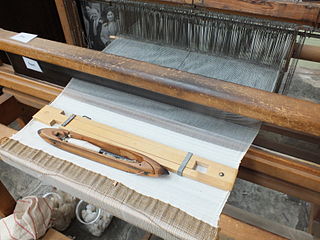
A temple is an adjustable stretcher used on a loom to maintain the width and improve the edges of the woven fabric.

Trude Guermonprez, was a German-born American textile artist, designer and educator, known for her tapestry landscapes. Her Bauhaus-influenced disciplined abstraction for hand woven textiles greatly contributed to the American craft and fiber art movements of the 1950s, 60s and even into the 70s, particularly during her tenure at the California College of Arts and Crafts.
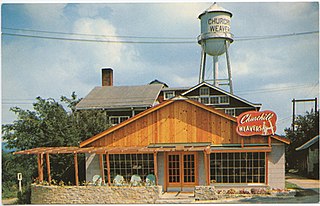
Churchill Weavers was a handweaving company that operated from 1922 to 2007 in Berea, Kentucky, an area of Appalachia long associated with handcrafts.
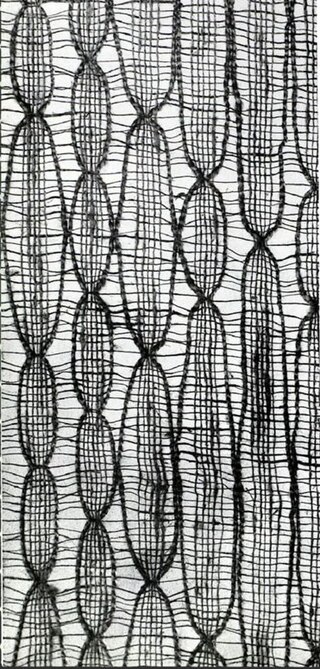
Kay Sekimachi is an American fiber artist and weaver, best known for her three-dimensional woven monofilament hangings as well as her intricate baskets and bowls.
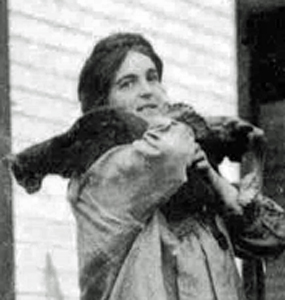
Mary Meigs Atwater was an American weaver. She revived handweaving in America by collecting weaving drafts, teaching and writing; Handweaver and Craftsman called Atwater "the grand dame and grand mother of the revival of handweaving in [the United States]".
Margaretha Reichardt, also known as Grete Reichardt, was a textile artist, weaver, and graphic designer from Erfurt, Germany. She was one of the most important designers to emerge from the Bauhaus design school's weaving workshop in Dessau, Germany. She spent most of her adult life running her own independent weaving workshop in Erfurt, which was under Nazi rule and then later part of communist East Germany.
Suzie Liles is an American fiber artist, master weaver, the owner of the Eugene Textile Center and co-owner of Glimakra USA, in Eugene, Oregon.
Karen Bulow was a Danish-born Canadian textile artist.

Abigail M. Franquemont is an American textile crafts writer, lecturer and educator, based in Cusco, Peru. She spent her early childhood among the Quechua people of Chinchero, Peru, where "women spun to eat and pay for the home they lived in." As a revivalist of the ancient art of hand spinning with the spindle, she published her book, Respect the Spindle, in 2009.

Smriti Morarka is an Indian social activist reviving handwoven cloth and improving mental health. In 2019 she was awarded the "Woman Power Award" Nari Shakti Puraskar by the President of India on International Women's Day in recognition of the example she has made.

Mary Zicafoose is an American textile artist, weaver, and teacher who specializes in ikat, an ancient technique in which threads are wrapped, tied and resist-dyed before weaving. Zicafoose is the author of Ikat: The Essential Handbook to Weaving Resist-Dyed Cloth (2020). Her works are part of private and public collections, including at least 16 embassies around the world as part of the U.S. Art in Embassies Program.















